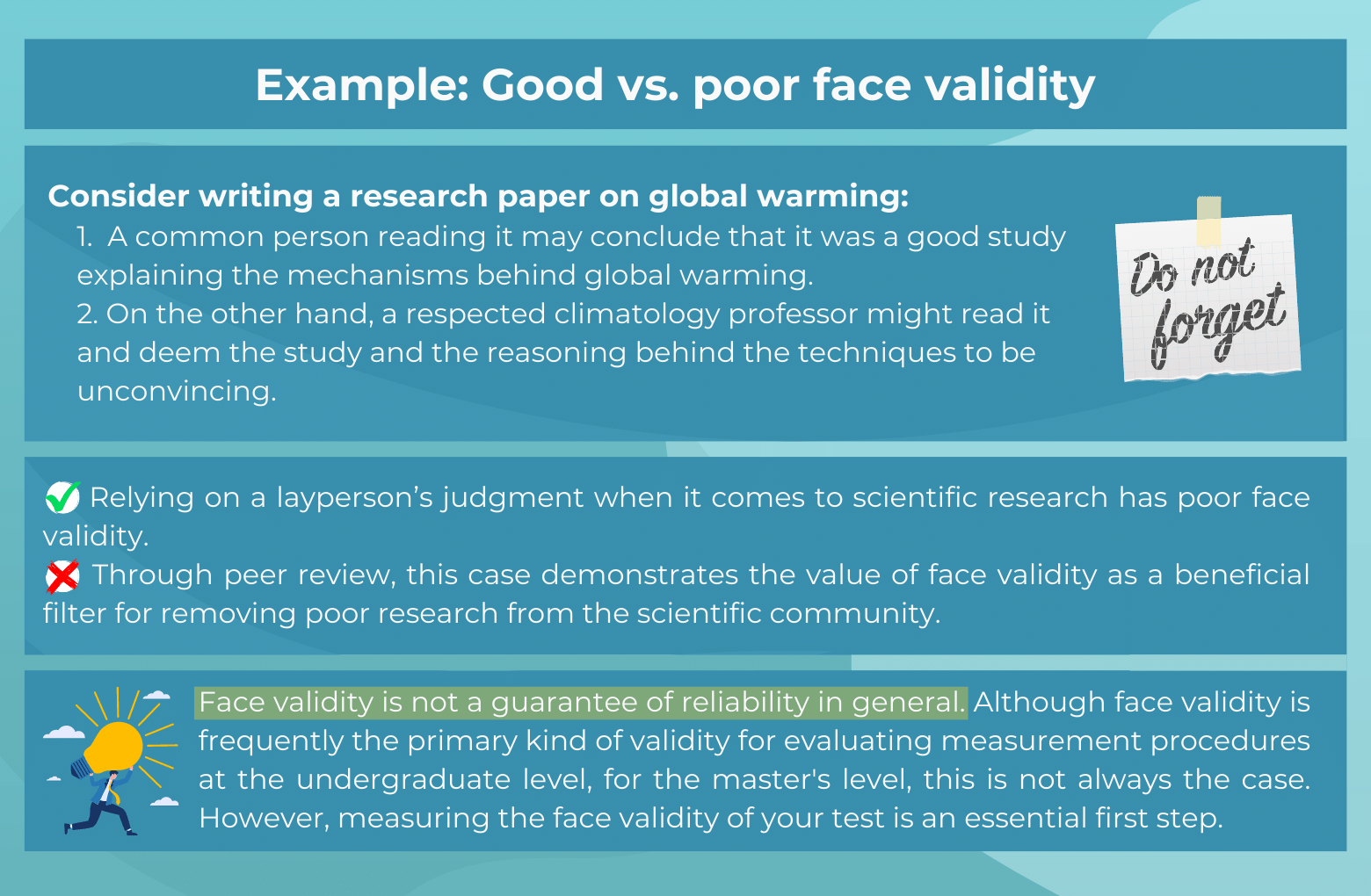Face Validity: A Short Guide with Definition and Examples
Face validity (sometimes referred to as logical validity) is a basic type of validity in which you make a quick, subjective judgment about whether or not your study or test actually measures what it is meant to measure. This kind of validity is focused on how relevant and appropriate a measure appears to be for the item it is evaluating.
A researcher can conduct a survey to measure people's levels of self-esteem. Then, after reviewing the questions, a colleague might decide that the survey is legitimate just based on its face value. In other words, the survey appears to be constructed in a way that makes it a useful instrument for measuring self-esteem levels.
Why is Face Validity Used?
Face validity is important since it is an easy method for measuring a test's or a study's general validity. It is a rather simple, fast, and easy way to determine whether a new measure appears useful at first glance. Although face validity is an informal measure of validity, it might be helpful for quickly eliminating poor research practices and techniques.
One can apply face validity when doing research and creating a measure for their research. The goal of face validity is to treat the experiment that the researcher has described as a sequence of questions that gather data (quantitative, quantitative, or both). When a colleague reviews the research study, they consider what they believe will or will not work in the study.
Therefore, face validity offers a rapid means of giving feedback on a test, quiz, or exam that does not seem to measure what it is meant to measure. If a test has face validity, students will probably check for other, more strict types of validity, such as criteria validity, content validity, etc.

Who Needs to Measure Face Validity?
Different groups need to measure face validity. It would be uncommon to mix the types of respondents because each could offer fairly different answers. Researchers would choose each type of respondent for different reasons:
- Test takers: Test takers will occasionally offer feedback on the test's face validity.
- People who work with the tests: Researchers could offer an opinion on the test's face validity.
- People interested in the test subject: Researchers can seek out members of the general public who are interested in the test subject or who fit specific requirements.
If a participant believes they have to name the top hockey players in the league, they would ask, "How many times this year have you played in the A team?" After all, it would seem logical that the top players would have played most games for the A team. The test takers will believe that the research has strong face validity.
The number of times a player has played for the A team, however, may not actually be a fair indicator of the best hockey players. Despite spending a lot of time on the rink, players may not shoot many "pucks". By choosing younger players for easier games, the coach may seek to give them more experience. According to the person interested in the test subject, the research has low face validity.
When to Measure Face Validity
Getting a face validity indicator is important early in the research process and whenever an existing test is used under new circumstances or with different populations. Here are three scenarios where it is necessary to (re-)evaluate face validity.
When creating a new test or measurement
One major bank has improved customer service. As part of the new initiative, bank representatives asked customers sample questions about their thoughts on the bank's mortgage rates.
The results of follow-up research showed that respondents left the survey since it had little to do with the issue they had called about. Customers also wanted to express their dissatisfaction with the automatic responding system and the representatives' refusal to address their complaints. This is what happens when a test has no face validity.
When applying an old test to a population it was not designed for
You try to assess English language skills for a study. You take a language test designed for college students in the US to give to college students in the Philippines.
Teachers, other researchers, and prospective participants all look at your test's face validity in the Philippines. They all agree that the test has poor face validity because several of the questions are US-culture-specific.
When using a test in a completely new context.
You ask participants to report their daily activities and moods using an app for mental health. You turn an existing test into a short-form version so that you can quickly gather and analyze every data day for a week.
The original test has 15 questions, while your new version has only five. The participants and your peers think that your short version is understandable, simple, and has strong face validity.
